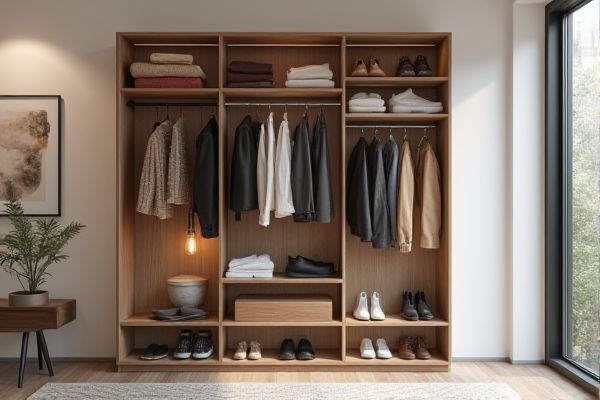
A slim shoe cabinet offers a space-saving design ideal for narrow entryways, while a regular shoe cabinet provides larger storage capacity suited for bigger areas. Discover which option best fits Your home by exploring the detailed comparison in this article.
Table of Comparison
| Feature | Slim Shoe Cabinet | Regular Shoe Cabinet |
|---|---|---|
| Design | Narrow, space-saving | Bulkier, traditional design |
| Capacity | Holds fewer pairs (6-10) | Holds more pairs (12-20+) |
| Placement | Ideal for small spaces, hallways | Suitable for larger rooms, entryways |
| Material | Often lightweight materials | Heavier, more durable materials |
| Price | Generally affordable | Varies, often more expensive |
| Accessibility | Quick access to shoes due to slim design | More storage but may require more effort to access |
Introduction: Slim Shoe Cabinet vs Regular Shoe Cabinet
Slim shoe cabinets maximize storage in narrow or confined spaces, making them ideal for apartments or small entryways where space efficiency is crucial. Regular shoe cabinets offer larger capacity, often featuring multiple shelves and compartments to accommodate extensive shoe collections but require more floor area. Choosing between the two depends on balancing storage needs with available space and aesthetic preferences.
Design and Space Efficiency
Slim shoe cabinets feature a narrow profile and vertical storage design that maximizes space efficiency in compact areas, ideal for small entryways and tight corridors. Regular shoe cabinets offer greater storage capacity with wider shelves but require more floor space, making them better suited for larger rooms. The slim design often incorporates sleek, minimalist aesthetics that blend seamlessly with modern interiors, while regular cabinets provide more versatile organization options for varied footwear collections.
Storage Capacity Comparison
Slim shoe cabinets maximize vertical space with narrow depths and multiple tiers, offering efficient storage without occupying much floor area, ideal for small entryways. Regular shoe cabinets typically feature deeper shelves and larger compartments, accommodating bulkier footwear and higher volumes but requiring more space. Choosing between the two depends on balancing available floor space with the number and type of shoes needing storage.
Material and Build Quality
Slim shoe cabinets typically utilize lightweight materials like MDF or particleboard with laminate finishes, optimizing for compactness and space efficiency, while regular shoe cabinets often feature solid wood or higher-grade plywood for enhanced durability and sturdiness. The build quality of slim cabinets prioritizes minimalistic design and functional storage, sometimes compromising on long-term robustness, whereas regular cabinets emphasize structural integrity with reinforced joints and thicker panels. Choosing between the two depends on the balance between space-saving needs and preferences for material longevity and build strength.
Suitability for Small Spaces
Slim shoe cabinets offer a compact design ideal for optimizing storage in small spaces such as narrow entryways and tight hallways, maximizing vertical space without overwhelming the room. Regular shoe cabinets, while typically providing greater storage capacity, require more floor area, making them less suitable for confined areas. Choosing a slim shoe cabinet enhances space efficiency and maintains a clutter-free environment in limited living spaces.
Aesthetics and Home Decor Integration
Slim shoe cabinets offer a sleek, space-saving design that seamlessly integrates into modern home decor, maintaining a minimalist aesthetic without overwhelming your entryway. Regular shoe cabinets provide ample storage but tend to be bulkier, potentially disrupting the visual flow of a room with traditional, bulky furniture styles. Choosing a slim shoe cabinet enhances your home's aesthetic appeal by combining functionality with subtle elegance, perfectly complementing contemporary or compact living spaces.
Ease of Installation and Maintenance
Slim shoe cabinets typically offer easier installation due to their compact size and lightweight design, requiring fewer tools and less time compared to regular shoe cabinets. Maintenance is also simpler with slim cabinets, as their smaller surface area reduces dust accumulation and makes cleaning quicker. In contrast, regular shoe cabinets may involve more complex assembly and require more effort for upkeep due to larger dimensions and additional compartments.
Price Differences and Value for Money
Slim shoe cabinets generally cost less than regular shoe cabinets due to their smaller size and reduced material usage, making them a more budget-friendly option for limited spaces. Regular shoe cabinets, while often pricier, provide greater storage capacity and durability, delivering better value for households with multiple shoes or frequent use. Choosing between them depends on balancing space constraints against long-term storage needs and investment.
Pros and Cons of Slim Shoe Cabinets
Slim shoe cabinets maximize storage in tight spaces, offering a sleek design ideal for narrow hallways or small apartments without overcrowding the area. Their compact size limits storage capacity compared to regular shoe cabinets, making them less suitable for large shoe collections. While slim shoe cabinets enhance space efficiency and maintain a minimalistic aesthetic, their limited shelves may require more frequent organization and rotation of footwear.
Choosing the Right Shoe Cabinet for Your Needs
Slim shoe cabinets maximize storage in tight spaces, making them ideal for small apartments or narrow entryways, while regular shoe cabinets offer greater capacity suitable for larger families or extensive shoe collections. Consider factors such as available space, number of shoes to store, and room layout when choosing between the two. Selecting a shoe cabinet with adjustable shelves or modular design enhances flexibility and long-term usability.
 homyna.com
homyna.com